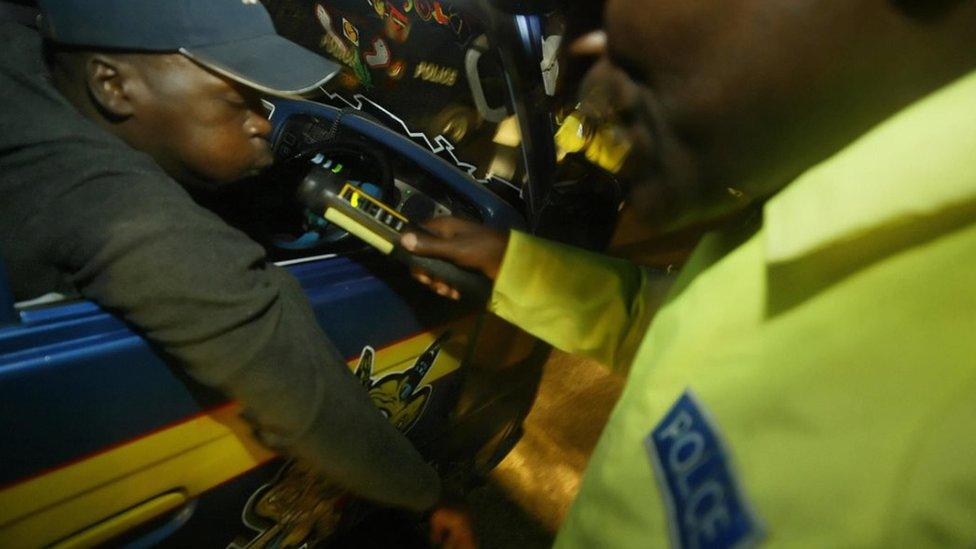
 A driver using a breathalyser/HANDOUT
A driver using a breathalyser/HANDOUT
The reintroduction of Alcoblow on Kenyan roads has been part of broader efforts to curb road accidents attributed to drunk driving.
For instance, in November 2023, the National Police Service announced plans to deploy Alcoblow breathalyzers on major highways ahead of the festive season, aiming to deter motorists from driving under the influence.
Roads and Transport Cabinet Secretary Davis Chirchir recently revealed that the National Transport and Safety Authority (NTSA) and police will be conducting random checks on major highways.
The checks will include the use of alcoblow, breathalyzer, on major roads to curb the increasing rate of road accidents.
The decision followed a picture that went viral of a vehicle that was involved in a fatal accident with a bottle of whiskey inside.
Chirchir said any person who shall be convicted of drinking and driving will be disqualified from obtaining a license for a period of one year.
“We are going to deploy 1,000 breathalyzers on major roads to ensure that if discipline is a problem, we help those who want to drink by denying them the chance to drive for one year, fining them Sh100,000, or sentencing them to up to two years in prison,” the CS said.
NTSA data indicates that 1,139 people died in road accidents between January 1 and March 31, 2025.
This is compared to 1,166 who died in the same period last year.
Any driver caught under the influence of alcohol beyond the prescribed limit shall be fined up to Sh100,000 or face an imprisonment of a term not exceeding two years, or both.
In Kenya, the legal limit for driving under the influence of alcohol, as measured by a breathalyzer, is 35 microgrammes of alcohol in 100 milliliters of breath.
The random checkpoints are backed by the Traffic (Drink-Driving) Rules, 2025, birthed through the amendment of Section 4 of the Traffic Act, CAP 403.
Alcoblow, has since it was introduced on Kenyan roads, become one of the greatest fears to road users who drink and drive.
How does it work?
Alcoblow can function in two modes: active and passive. In active mode, the driver directly blows into the device, allowing for precise measurement of alcohol levels.
This versatility facilitates rapid screening of multiple individuals, making it particularly effective during roadside checks.
The breathalyzer works by using an electrochemical fuel cell sensor to detect and measure alcohol in exhaled breath, offering both active and passive modes for quick alcohol screening.
Active is where the subject blows into the device, while passive is where the device draws a sample of breath from the air around the subject when one is not able to directly blow into the breathalyzer.
Once the subject has blown into it, the device displays the results, typically using colored lights and/or beeps to indicate the presence or absence of alcohol.
The fuel cell reacts with the alcohol, and there is an electrical discharge that takes place from the fuel cell.
There is also a direct proportion depending on the amount of alcohol that is on the breath sample to how much electricity will come out.
According to the Office of Science and Society at McGill University, breath analyzers contain an anode (negatively charged electrode) and a cathode (positively charged electrode).
When you blow into a breathalyzer, the ethanol in your breath reacts with water from the air at the anode and is oxidized to form acetic acid (like in vinegar).
At the cathode, oxygen from the atmosphere is reduced to form water.
These two coupled reactions produce an electrical current between the electrodes that’s proportional to the amount of ethanol present in your breath.
Breathalyzers don’t truly measure blood alcohol content but estimate it based on the ethanol in your breath.
There are a few situations in which a breathalyzer may fail to measure accurately.
CONCERNS
While Alcoblow serves as a critical tool in promoting road safety, concerns have been raised regarding its hygienic use.
The device can accumulate moisture from repeated use, potentially exposing individuals to communicable diseases if not properly sterilized between tests.
To mitigate this risk, it's essential for law enforcement agencies to adopt stringent hygiene protocols, such as using disposable mouthpieces or implementing effective sterilization methods.
In summary, Alcoblow plays a pivotal role in Kenya's strategy to combat drunk driving by providing a quick and reliable method for detecting alcohol consumption among drivers.
Its effective deployment, coupled with adherence to legal standards and hygiene practices, contributes significantly to enhancing road safety across the nation.










